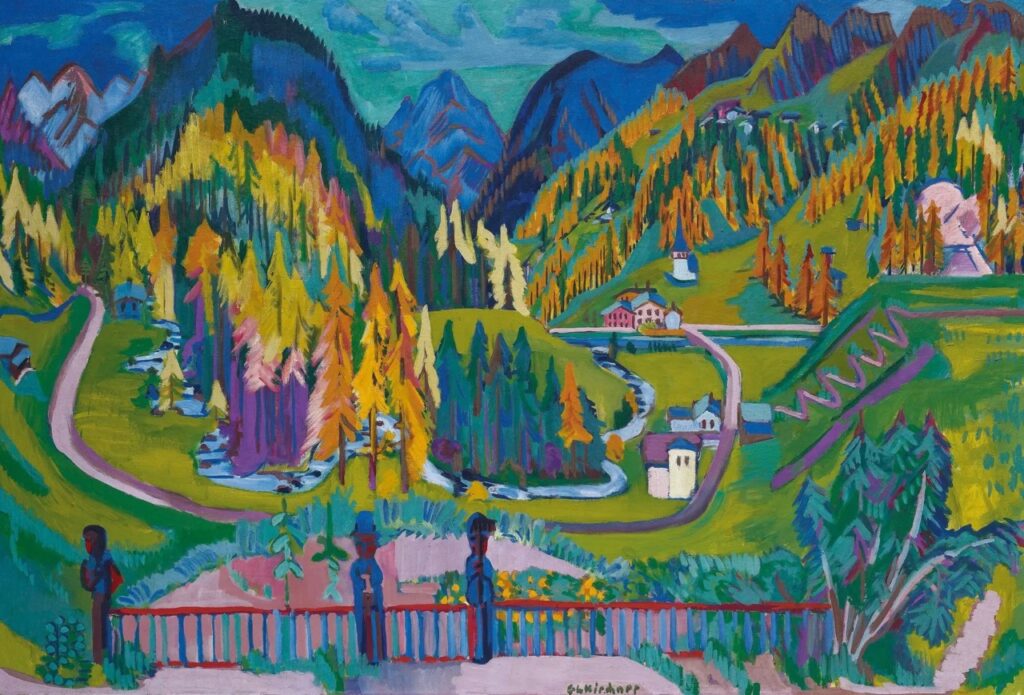 “Sertig Valley in Autumn” was painted by Ernst Ludwig Kirchner in 1925. Kirchner was a founder of the Die Brücke style of German Expressionism, which emerged in the early 20th century in Dresden as a rejection of traditional artistic styles. “Brücke” translates to bridge, and these artists saw themselves as a sort of bridge between the artistic world and the bourgeois. The group became defined by bright colors and intense emotion in scenes sometimes communicating radical political views. A manifesto from Die Brücke written in 1906 states that their goal was to “achieve freedom of life and action against the well-established older forces” (Brücke, n.d.).
“Sertig Valley in Autumn” was painted by Ernst Ludwig Kirchner in 1925. Kirchner was a founder of the Die Brücke style of German Expressionism, which emerged in the early 20th century in Dresden as a rejection of traditional artistic styles. “Brücke” translates to bridge, and these artists saw themselves as a sort of bridge between the artistic world and the bourgeois. The group became defined by bright colors and intense emotion in scenes sometimes communicating radical political views. A manifesto from Die Brücke written in 1906 states that their goal was to “achieve freedom of life and action against the well-established older forces” (Brücke, n.d.).
The Sertig Valley is located in Davos, Switzerland. After serving in the German Army in 1915, Kirchner had a mental breakdown and became addicted to morphine. He traveled to a sanatorium in Davos to retreat from the war and his former city life. This self-imposed exile in Switzerland lasted until his death in 1938. He was blacklisted by the Nazis, and fearing that they might invade Switzerland took his own life. In his time in Davos, Kirchner was fascinated by the sturdy characters and simple lives of his Swiss neighbors. His work here received less acclaim but focused more on the beauty of nature and human connection to it.
This painting depicts a mountain vista and small village along a winding river, foregrounded by three figures, perhaps hiking in the mountains, overlooking the valley along with the viewer. The brushstrokes are rough and expressive. Bright blues, yellows, greens, and pinks are layered beside each other, giving the painting a vivid, dream-like quality. While the Expressionist landscapes painted by Kirchner’s comrades back in Germany turned more muted and somber as the war progressed, the joy of his freedom and security is evident in the painting’s boisterous character. This contrast highlights how the political and emotional environments shape artist’s work as much, if not more, than the physical. Kirchner’s experience of the Sertig Valley is literally colored by his personal experience of healing.
For many German Expressionists, their goal “achieve freedom of life” through art was continually challenged by oppressive forces. Kirchner’s retreat from conflict and fear perhaps made possible the realization of this goal. The Sertig Valley is not a German environment per se, but painted by a German in an era of increased emigration and oppression, it is a bright example of beauty and reprieve.
References
Brücke. (n.d.). Tate. Retrieved April 23, 2023, from https://www.tate.org.uk/art/art-terms/b/brucke
German Expressionism—One of the Greatest German Art Movements. (2021, February 15). Artincontext.Org. https://artincontext.org/german-expressionism/
German Expressionism Themes: Nature. (n.d.). MoMA. Retrieved April 23, 2023, from https://www.moma.org/s/ge/curated_ge/themes/nature.html
Siegal, N. (2015, December 2). Mountains as Muse for a Self-Exiled Artist. The New York Times. https://www.nytimes.com/2015/12/03/arts/international/mountains-as-muse-for-a-self-exiled-artist.html
